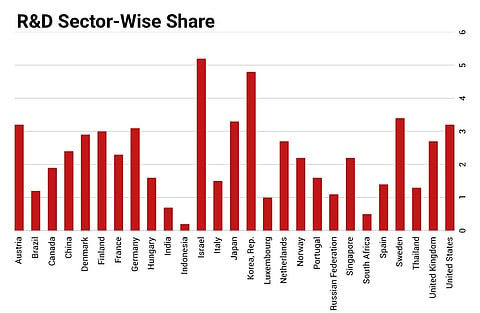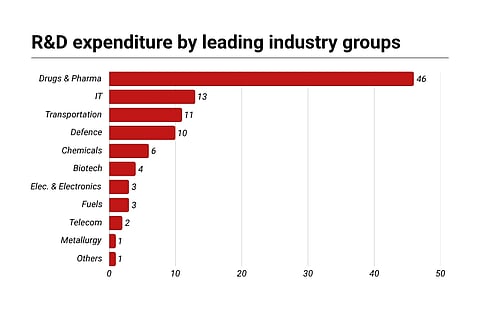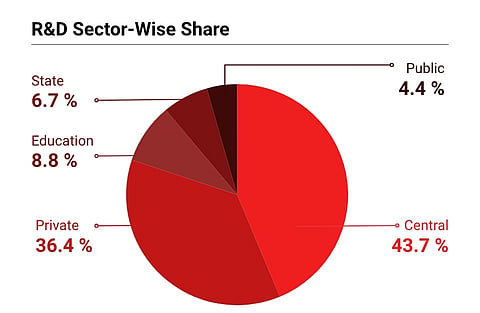The Union Cabinet, chaired by Prime Minister Narendra Modi, has approved a new scheme to encourage private sector investment in research and development, with a corpus of ₹1 lakh crore. The Research, Development and Innovation (RDI) Scheme will provide long-term financing or refinancing with extended repayment periods at low or zero interest rates to promote private sector participation in RDI, the government said in a statement.
Govt Nudges India Inc with ₹1 Lakh Crore Scheme for R&D: Is This the Push They Need?
The first announcement of the ₹1 lakh crore fund for industrial research and innovation was made during the Interim Budget for 2024–25 on February 1, 2024, by Finance Minister Nirmala Sitharaman
"The scheme has been designed to address the challenges in funding for the private sector and aims to provide growth and risk capital to strategic and emerging sectors to support innovation, promote technology adoption, and enhance competitiveness," the statement added.
The first announcement of the ₹1 lakh crore fund for industrial research and innovation was made during the Interim Budget for 2024–25 on February 1, 2024, by Finance Minister Nirmala Sitharaman. In the Budget for 2025–26, Sitharaman said, "To implement the private sector-driven Research, Development and Innovation initiative announced in the July Budget, I am now allocating ₹20,000 crore."
How the Fund Will Be Allocated
The Governing Board of the Anusandhan National Research Foundation (ANRF), chaired by the Prime Minister, will provide strategic direction to the RDI Scheme. The Executive Council of ANRF will approve the scheme’s guidelines and recommend second-level fund managers and types of projects in different sectors.
An Empowered Group of Secretaries, led by the Cabinet Secretary, will be responsible for approving changes to the scheme, selecting sectors and project types, approving second-level fund managers, and reviewing the scheme’s performance. The Department of Science and Technology will act as the nodal department for implementing the RDI Scheme.
The scheme will operate on a two-tier funding model. At the first level, a Special Purpose Fund within ANRF will manage the corpus. This fund will allocate money to second-level fund managers, mainly in the form of long-term loans.
Funding for research and development projects will come as loans with low or no interest. In some cases, equity funding may be used, especially for startups. Contributions may also be made to a Deep-Tech Fund of Funds or similar structures meant for RDI.
Key objectives of the scheme include encouraging private sector participation in research, development, and innovation in strategic sectors important for economic and national security. The scheme also aims to support projects with higher levels of technological readiness, help acquire critical technologies, and facilitate the setup of a Deep-Tech Fund of Funds.
The scheme was announced alongside several other Cabinet decisions on Tuesday, including ₹1 lakh crore for the Employment Linked Incentive (ELI) Scheme, which aims to generate more than 3.5 crore jobs in two years. The Cabinet also approved construction of a 4-lane Paramakudi–Ramanathapuram section (NH-87) in Tamil Nadu at a cost of ₹1,853 crore, and cleared the new National Sports Policy (NSP) 2025, replacing the 2021 policy with a focus on the 2036 Olympic Games.
India Inc's R&D Problem
The government has long been concerned about the limited research and development activity by the private sector. The issue has been highlighted repeatedly by various departments.
In the Economic Survey of 2024–25, Chief Economic Advisor V. Anantha Nageswaran noted that while India’s strengths in frugal innovation, scientific talent, IT and pharma industries, start-up ecosystem, and policy support have enabled progress, the country still lags in research and development, with major gaps across sectors.

"The gross expenditure on research and development (GERD) in India increased from approximately ₹60,196 crore in FY11 to about ₹127,381 crore in FY21. However, this is only 0.64% of GDP, which is insufficient and remains low compared to many countries that have advanced in R&D," he said.
The Economic Survey further noted that in most developed and emerging economies, businesses contribute over 50% of total research spending. In countries like the United States, China, Japan, and South Korea, this figure exceeds 70%.


In India, however, industrial research is limited and concentrated in sectors like pharmaceuticals and information technology, while public sector research is mostly defence-oriented. India's historical focus has been on basic research, which lacks practical applications.
To address this gap, the survey recommended enhancing collaboration between industry and academia, increasing private sector involvement, and shifting the focus toward applied research.
"While government R&D policies and interventions have made consistent efforts, there is a need for greater private sector contribution. Currently, R&D funding in India is mostly provided by government agencies," Nageswaran stated.

